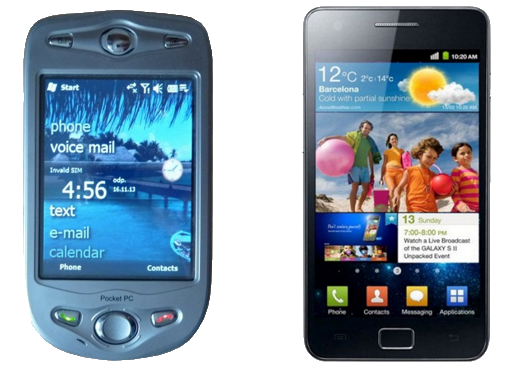Monitors with Trueflat design
A Trueflat screen is a frameless screen. Surprisingly, few people can imagine what this actually means. However, almost all touchscreens in the CODEWARE range have a Trueflat design.
Let's use the smartphone example. The difference between a Trueflat monitor and a classic LED computer monitor can be described very clearly. Take a look at the following picture, where a mobile phone that is over ten years old and a current model are side by side. Or take a look at your own mobile phone. It will immediately become clear what the term Trueflat means.

Nothing yet? Well, with a hint, then. The literal translation of true flat is "truly flat". So, do you know?
You got it! A Trueflat monitor has no bezel around the perimeter! The entire screen is one continuous sheet of tempered glass or glass-like polyacrylate. The main advantage of the Trueflat screen is obvious: if you accidentally spill water on it, nothing bad can happen. The water just runs down, there's nowhere for it to go. Another advantage of this type of monitor is that it is easy to wash and therefore still visible after many years of use. A normal LED screen, which you can't wash, is littered with tiny dried droplets of all sorts of things after a while. Who knows where they come from, but you can't avoid it. Thirdly, in addition to greater durability and better imaging performance, design also plays a role. The Trueflat monitor still stays beautifully clean and glossy. With a regular bezel screen, the areas near the edges and in the corners get clogged with dirt after a while, and you simply can't remove it. Don't tell me you don't mind if hundreds or thousands of your customers see your checkout screen every day!
We have had the idea in the past to use the mobile phone as a benchmark to illustrate some of the features of the goods we sell.
That time a customer bought several CipherLab RS30 mobile terminals from us. A few days later, he requested delivery of styluses. These are those pencils that you tap on the touchscreen with. The problem was that the manufacturer didn't make any styluses for the RS30. And why would they? The device is operated with your fingers - just like any other Android smartphone.
We could have responded to the customer's inquiry by saying, "Please, sir, try to remember the last time you used a stylus on your mobile phone?" The customer on the other end of the phone line is not stupid. He certainly has years of experience using similar portable terminals. All of them have always used a stylus, and many of them still do. His request is perfectly logical. It's just that his job description is something completely different from keeping up with the latest developments in mobile terminals and barcode scanners.
Rather than asking a rude, simple question that would have brought instant clarity to the matter, we spent ten minutes explaining the differences between the resident touchscreens of yesteryear and today's capacitive technology the reasons why a stylus can't be a simple plastic stick, as it used to be, but something conductive and certainly multiplemore expensive than he expects, and whether he really needs a stylus and therefore whether we should start looking for one.
Monitors with a screen in the frame will gradually disappear from the market. This is not the first time that the evolution of technology in mobile phones has shown us the future trend in related areas, and it wasn't just the two examples given of capacitive touch panel or Trueflat monitor design. There are orders of magnitude more smartphone users than computer users, electronic cash registers or mobile terminals, that's the point. If the Trueflat screen has made such a clear impact on phones, it will be no different for touchscreen monitors.





